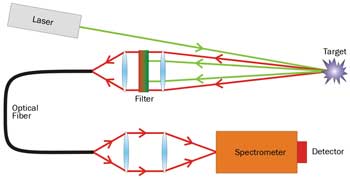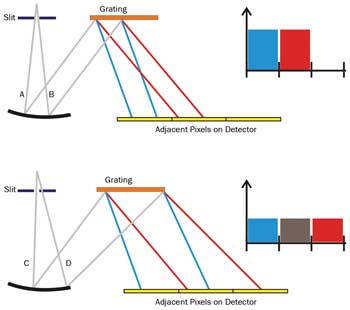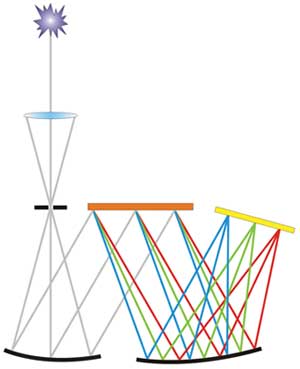Michael J. Foster and Jonathan Storey, IS-Instruments Ltd.
Raman spectroscopy is becoming increasingly prevalent in commercial applications. Challenges include making remote measurements of chemical species in high-pressure or high-temperature environments while customers demand compact
instrumentation with ever-greater sensitivity. These obstacles require new approaches such as fiber-coupled spectrometers with greater throughput.
How Raman works
Raman spectroscopy was first discovered in 1928 by C.V. Raman1 and has been of practical interest as a potential molecular identification tool since the development of the laser in the 1960s. To generate a Raman spectrum, a photon of incident light strikes a molecule (see figure in this box) and imparts energy; the subsequent vibration/rotation of the molecule releases a photon, typically of lower energy than the intercept light (Stokes). Each mode of vibration/rotation can release a photon with a characteristic energy signature. This leads to a “spectral fingerprint” that can be used to identify the molecule.
The primary advantage of Raman measurements over absorption techniques is that multiple species can be examined simultaneously from a single excitation wavelength, potentially leading to simple and cost-effective solutions. The primary disadvantage of Raman spectroscopy is that the Raman scattering cross sections are very small, so detecting a Raman signal can be difficult. To date, this has limited the commercial exploitation of the technique due to the need for relatively large laser powers (>100 mW) and high-quality detectors to generate good signal-to-noise measurements from small samples.
Commercial, environmental and social pressures on industry are encouraging industrial users to seek more efficient solutions for process control and quality management. Raman spectroscopy is one solution.
In recent years, the technique has become more widely accessible to a variety of industrial sectors, largely due to the improved capability and reduced cost of detectors and lasers. Improved factors such as spectral resolution and spectral range have allowed Raman methods to be used for numerous monitoring solutions, from pharmaceutical quality assurance to the detection of explosives in airports. However, current Raman system designs can be pushed only so far merely by using more advanced components. Spectrometer designs have not undergone radical improvements. As new methods of gathering the Raman spectrum have been developed, it is the spectrometer and not the laser or detector that has become the limiting factor.
Today, a large variety of Raman instruments is available, from handheld devices to highly complex, high-spectral-resolution benchtop systems. Most Raman systems today measure the backscattered signal from a sample. Normally these systems use a CW laser to illuminate the sample, typically operating at 785 nm to reduce issues with fluorescence of the sample contaminating the measurement. Where fluorescence remains an issue, time-resolved detection options have been used in combination with pulsed lasers, but these systems often are prohibitively expensive for industrial use.
In a simple fiber-coupled Raman system (Figure 1), the photons emitted from the sample are filtered to remove the contaminant Rayleigh scattering before they enter the spectrometer, which typically uses a high-quality imaging or line detector. Various techniques have been developed in recent years both to increase the strength and to improve the capture of Raman signals. The following three methods are briefly summarized here: spatially offset Raman (SOR), surface-enhanced Raman spectroscopy (SERS) and standoff Raman measurement.

Figure 1. Simple fiber-coupled Raman spectrometer. Photons emitted from the sample are filtered to
remove the contaminant Rayleigh scattering before entering the spectrometer.
In SOR,2 the target is illuminated off the receiver axis, so backscatter signal measurement is replaced with measurement of Raman photons from an offset position. This has two key advantages: It reduces signal contamination from the sample container, and it helps ensure that a bulk measurement of the sample is made, rather than a localized one. An extreme version of this approach is transmission Raman, where the forward-scattered signal is measured. This provides excellent bulk measurement, opening up avenues in quality-assurance applications. The main drawback is that most spectrometers cannot take full advantage of this effect, as light must be gathered from as large an area of the sample as possible, which means that the spectrometers must have increased throughput (also known as etendue, or AΩ, where A is the sample area and Ω is the solid angle).
SERS is one method to increase the actual Raman-scattering cross section. Since its discovery and initial investigation in the mid-1970s,3-5 SERS has generated a lot of scientific interest, as it can greatly enhance the strength of the Raman signal; in some cases, by more than 1 million times. This effect occurs when sample molecules are brought into contact with metals, especially gold, silver and copper. This enhancement allows single molecules to be studied in detail, but the fact that the sample has to be brought into contact with these metals has thus far limited the commercial applications of this approach.
In standoff Raman systems, the instrument is a fixed distance up to several meters from the target. Potential applications for this approach include dangerous targets, such as chemical spills, or those that are not easily accessible. The signal strength is a function of the distance to the target (see Equation 1).

Where Lph is the number of laser photons fired at the target per second, AT is the receiver area, IE is the total instrument efficiency, α is the total Raman scattering cross section, T is the atmospheric transmission, and R is the distance to the target. Most Raman systems make measurement from a distance of 1 cm or less; therefore, moving to a distance of 2 m results in a factor-of-40,000 drop in the signal gathered, which requires compensation.

Figure 2. An illustration of spectrometer throughput. (a) The
throughput is matched with rays A and B passing through the small slit
within the instrument field of view. (b) The throughput is incorrectly
matched with ray D and does not pass correctly through the small slit.
In all cases, the final performance of any Raman spectrometer will be driven by the total amount of light gathered. In spatially offset and standoff measurements, examining diffuse sources is often also a requirement. Both issues are often restricted by the throughput of the spectrometer being used. All spectral resolving devices have a throughput restriction to achieve a given spectral resolution: As the resolution of a given spectrometer increases, the throughput decreases. Any light that comes from outside will result in a loss of resolution in the device, unless the light is removed. In most diffraction-grating-based devices, this is achieved by using a slit, illustrated simply in Figure 2.
This shows a basic diffraction-based spectrometer operating in two cases. The top image shows the device operating correctly, with the throughput matched by using the appropriate slit to limit the light entering. The red and blue lights are distinct and observed clearly at the detector. In the bottom case, the spectrometer throughput is incorrectly matched for ray D and requires a larger slit. In this case, the spectral response becomes blurred – and, hence, the resolution is lost.
Many current Raman spectrometers use a Czerny-Turner configuration (Figure 3). The throughput of this device is given by the slit width multiplied by the f number of the collecting lens. This design has many advantages in that it has no moving parts, it can be made from simple components, and it gathers the spectrum as a single measurement. However, to achieve a good spectral resolution (<0.3 nm), a very small slit is required, typically less than 100 µm when using an f/2 lens. This limited throughput can result in a loss of light when examining diffuse targets, as in Raman transmission experiments.

Figure 3. An example of a Czerny-Turner spectrometer. The throughput is given by the slit width multiplied by the f number of the collecting lens.
Extending the Czerny-Turner throughput has been the source of much research; recently, some systems with a reasonable level of improvement have come on the market from major producers, but at significant cost.
Another approach is to use fiber bundle: After multiple fibers collect the light, they are stacked within a spectrometer using an array detector to form multiple spectrometers across the detector (Figure 4). The advantage of this approach is that it can be exploited in combination with almost any spectrometer design. In principle, the only restriction on the number of fibers that can be used is the size of the array detector.
Samples also can be taken from multiple targets and examined simultaneously at the spectrometer. The disadvantage of this method is that the system designs can become complicated and therefore costly. A further disadvantage is that the target area from which light is being gathered is significantly lower in a fiber bundle system than in a system using a single large-core fiber.

Figure 4. Fiber bundle collection system. Multiple fibers collect the light and are stacked within a spectrometer using an array detector to form multiple spectrometers across the detector.
An alternative approach to gathering the spectrum is using a Fabry-Perot or Michelson interferometer. Typically, a Michelson interferometer will offer at least a factor 100 increase in the throughput over that achieved by a Czerny-Turner system for the same bandpass. However, standard Michelson devices are constructed from high-quality optical components and must be physically tuned to achieve the required spectral coverage – and therefore do not acquire the spectrum in a single integration. This can make these devices expensive and slow – and, in demanding environments, reliability is always a concern with systems that contain moving parts.
Given the restrictions of the current options, a number of new diffraction-grating spectrometers have become commercially available. These include the HES spectrometer from IS-Instruments Ltd.,6 which offers the same throughput as the interferometric devices while maintaining many of the properties of the diffraction-grating-based systems. This is achieved by acquiring the spectrum spatially within the Fourier domain. This system and similar ones have a throughput 100 times greater than a Czerny-Turner device; they also require no slit and can be coupled directly to large multicore fibers. This not only improves the amount of light that can be gathered from diffuse sources, and hence the signal-to-noise ratio, but it also allows the devices to be more easily integrated in complete Raman systems.
These advances in spectrometer design, coupled with steady progression in laser technology, will clearly result in more widespread use of Raman spectroscopy in industrial applications. In particular, applications using SOR, transmission and standoff Raman are expected to be large growth areas. Increasing the throughput in particular is likely to increase the use of Raman systems in quality assurance and counterfeit detection applications where it is critical that an entire sample area (for example, up to 6 mm in diameter for a pharmaceutical tablet) be measured.
Raman systems are beginning to provide a real measurement opportunity for commercial and industrial users. All this leads to a potentially exciting future for the technology, where Raman systems could become commonplace across a variety of sectors.
Meet the authors
Michael J. Foster is a director at IS-Instruments Ltd. in Kent, England; [email protected]. Jonathan Storey is a director at IS-Instruments Ltd.; email: [email protected].
References
1. C.V. Raman (1928). A new radiation. Indian J Phys, Vol. 2, pp. 387-398.
2. P. Matousek et al (April 2005). Subsurface probing in diffusely scattering media using spatially offset Raman spectroscopy. Appl Spectr, Vol. 59, Issue 4, pp. 393-400.
3. M. Fleischmann et al (May 15, 1974). Raman spectra of pyridine adsorbed at a silver electrode. Chem Phys Lett, Vol. 26, Issue 2, pp. 163-166.
4. D.L. Jeanmaire and R.P. van Duyne (1977). Surface Raman electrochemistry Part I. Heterocyclic, aromatic and aliphatic amines adsorbed on the anodized silver electrode. J Electroanal Chem, Vol. 84, pp. 1-20.
5. M.G. Albrecht and J.A. Creighton (1977). Anomalously intense Raman spectra of pyridine at a silver electrode. J Am Chem Soc, Vol. 99, Issue 15, pp. 5215-5217.
6. www.is-instruments.com.